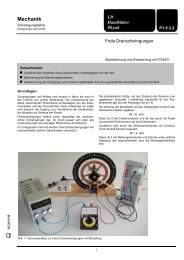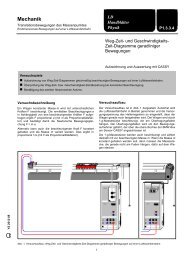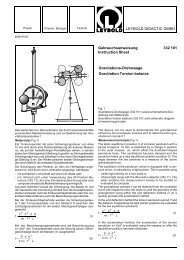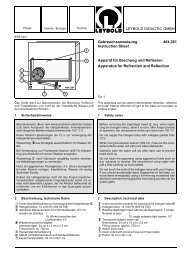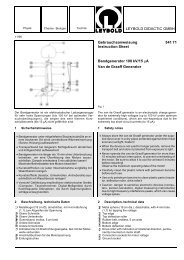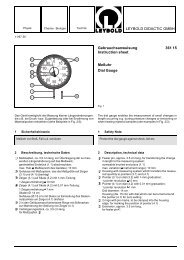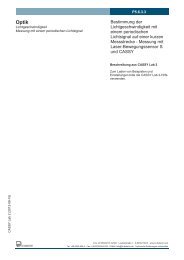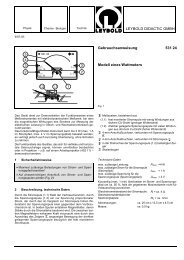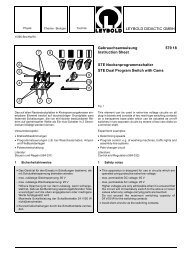LEYBOLD DIDACTIC GMBH Gebrauchsanweisung 667 509 ...
LEYBOLD DIDACTIC GMBH Gebrauchsanweisung 667 509 ...
LEYBOLD DIDACTIC GMBH Gebrauchsanweisung 667 509 ...
You also want an ePaper? Increase the reach of your titles
YUMPU automatically turns print PDFs into web optimized ePapers that Google loves.
2/96-Fi-<br />
Physik Chemie ⋅ Biologie Technik <strong>LEYBOLD</strong> <strong>DIDACTIC</strong> <strong>GMBH</strong><br />
Der Osmoseapparat dient zur Vorführung der Osmose und zum<br />
Nachweis des osmotischen Drucks.<br />
Prinzip<br />
Von zwei Flüssigkeiten unterschiedlicher Konzentration diffundieren<br />
die Lösungsmittelmoleküle der weniger konzentrierten<br />
Lösung (bzw. dem reinen Lösungsmittel) durch einen semipermeablen<br />
Dialysierschlauch in die konzentrierte Lösung, bis der<br />
erzeugte hydrostatische Druck gleich dem osmotischen Druck ist.<br />
1 Sicherheitshinweise<br />
Zur Vermeidung unbeabsichtigten Lösens<br />
Dialysierschlauch (2.2) zusätzlich mit zwei Gummiringen an<br />
Glashülle mit Stopfenbett (2.1) und am Schlauchverschluß<br />
(2.3) sichern.<br />
2 Lieferumfang, Beschreibung, technische Daten<br />
� Reagenzglas SB 29 mit seitlichem Ansatz<br />
� Osmotische Zelle<br />
(2.1) Glashülle mit Stopfenbett<br />
(2.2) Dialysierschlauch, 18 mm Ø<br />
(2.3) Schlauchverschluß<br />
� Gummistopfen SB 19, mit 1 Loch<br />
� Kapillarrohr, 400 mm lang, 8 mm Ø<br />
� Gummistopfen SB 29, mit 1 Loch<br />
ohne Abbildung:<br />
2 Ersatz-Dialysierschläuche<br />
<strong>Gebrauchsanweisung</strong> <strong>667</strong> <strong>509</strong><br />
Instruction Sheet<br />
Osmoseapparat<br />
Osmosis Demonstration Apparatus<br />
Fig.1<br />
The osmosis demonstration apparatus is used to demonstrate<br />
osmosis and to prove osmotic pressure.<br />
Principle<br />
Where there are two fluids of different concentration, the<br />
molecules of the solvent in the less concentrated solution (or<br />
pure solvent) diffuse through semi-permeable dialysis tubing<br />
into the more concentrated solution until the resulting hydrostatic<br />
pressure is equal to the osmotic pressure.<br />
1 Safety notes<br />
In order to prevent loosening of the dialysis tubing (2.2),<br />
additionally secure it to the glass tube with stopper (2.1) and<br />
the tubing stopper (2.3).<br />
2 Scope of supply, description, technical data<br />
� Test tube SB 29 with side arm<br />
� Osmotic cell<br />
(2.1) Glass tube with stopper<br />
(2.2) Dialysis tubing, 18 mm dia.<br />
(2.3) Tubing stopper<br />
� Rubber stopper, SB 19 with single hole<br />
� Capillary tube, 400 mm long, 8 mm dia.<br />
� Rubber stopper, SB 29, with single hole.<br />
Not shown:<br />
spare dialysis tubing, 2 ea.
3 Bedienung<br />
3.1 Notwendiges Zubehör<br />
Stativmaterial, z.B.:<br />
Kleiner Stativfuß, V-förmig 300 02<br />
Stativstange, 47 cm lang, Ø 12 mm 300 42<br />
Leybold-Muffe 301 01<br />
Universal-Stativklemme S 302 61<br />
1 Zeitmeßgerät, z.B.:<br />
Tischstoppuhr 313 05<br />
1 Überlaufbehälter, z.B.<br />
Becherglas, 400 ml 664 104<br />
1 Lineal (20 cm transparent)<br />
Färbepulver, z.B.:<br />
aus 309 42 Färbepulver, wasserlöslich<br />
2 Gummiringe, z.B.:<br />
aus 340 90 Packung Gummiringe<br />
Ersatzteil:<br />
Dialysierschlauch, 18 mm Ø, 1 m lang <strong>667</strong> 199<br />
Dialysierschlauch auf Glastülle <strong>667</strong> 508<br />
Vor der Inbetriebnahme müssen zuerst nacheinander die Gummistopfen<br />
mit einem Loch, SB 29 � und SB 19 � auf das Kapillarrohr<br />
geschoben werden (zur Erhöhung der Gleitfähigkeit<br />
Bohrung und Glas vorher mit etwas anfeuchten bzw. mit etwas<br />
Glyzerin einstreichen).<br />
Nach Füllen des Reagenzglases � mit destilliertem Wasser<br />
(ca. 90 ml) und der osmotischen Zelle � mit Zucker- oder Salzlösung<br />
(z.B. 2 g Zucker auf 20 ml destilliertes Wasser) setzt<br />
man das Kappillarrohr mit den Gummistopfen zunächst auf die<br />
osmotische Zelle und dann das gesamte System vorsichtig in<br />
das Reagenzglas �. Da eventuell zuviel eingefülltes destilliertes<br />
Wasser über den seitlichen Ansatz des Reagenzglases ablaufen<br />
kann, empfiehlt es sich, ein Überlaufgefäß (z.B. Becherglas)<br />
unter die aufgebaute Apparatur zu stellen. Durch Anlegen<br />
eines transparenten Lineals an die Kapillarröhre läßt sich jetzt<br />
die Höhe des Flüssigkeitsmeniskus bestimmen und die Steighöhenänderung<br />
als Funktion der Zeit darstellen.<br />
Färbt man die Lösung der osmotischen Zelle mit Färbepulver<br />
(309 42) ein, läßt sich der Flüssigkeitsstand leichter ablesen.<br />
Zum Aufziehen neuer Dialysierschläuche werden diese kurz in<br />
warmes Wasser gelegt und dann mit der Hand etwas gedehnt.<br />
Danach lassen sie sich leicht auf die Glasteile aufziehen.<br />
3 Operation<br />
3.1 Accessories required<br />
Stand equipment, e.g.:<br />
Stand base, V-shaped 300 02<br />
Stand rod, 47 mm long, dia. 12 mm 300 42<br />
Leybold multiclamp 301 01<br />
Universal clamp S 302 61<br />
1 time measuring device e.g.:<br />
Stopclock 313 05<br />
1 overflow container, e.g.<br />
1 beaker, 400 ml 664 104<br />
1 ruler (20 cm transparent)<br />
Coloring, e.g.<br />
from 309 42 coloring, red, water soluble<br />
2 rubber rings, e.g.:<br />
from 340 90 packet of rubber rings<br />
Spare part:<br />
Dialysis tubing, 18 mm dia., 1 m long <strong>667</strong> 199<br />
Dialysis hose <strong>667</strong> 508<br />
Before beginning, first insert the single hole rubber stoppers,<br />
SB 29 � and SB 19 � into the capillary tube (to make these<br />
slide more easily, moisten the hole and glass or lubricate it with<br />
a little glycerin).<br />
After filling the test tube � with distilled water, (approx. 90 ml)<br />
and the osmotic cell � with a sugar or salt solution, (e.g. 2 g of<br />
sugar in 20 ml of distilled water), the capillary tube complete<br />
with rubber stoppers is placed on the osmotic cell, and the whole<br />
system is then carefully placed in test tube �. As excess distilled<br />
water may overflow through the side arm of the test tube, it is<br />
recommended that an overflow container, e.g. a beaker be<br />
placed underneath the apparatus. Using a transparent ruler it is<br />
possible to measure the level of the meniscus in the capillary<br />
tube, and to represent the change in level as a function of time.<br />
The fluid level can be read off more easily if the solution is<br />
colored using red coloring powder (309 42).<br />
New dialysis tubing should be briefly placed in warm water and<br />
stretched a little by hand before fitting. After this, it is very easy<br />
to pull the ends onto the glass tube.<br />
<strong>LEYBOLD</strong> <strong>DIDACTIC</strong> <strong>GMBH</strong> ⋅ Leyboldstrasse 1 ⋅ D-50354 Hürth ⋅ Phone (02233) 604-0 ⋅ Telefax (02233) 604-222 ⋅ Telex 17 223 332 LHPCGN D<br />
© by Leybold Didactic GmbH<br />
Printed in the Federal Republic of Germany<br />
Technical alterations reserved


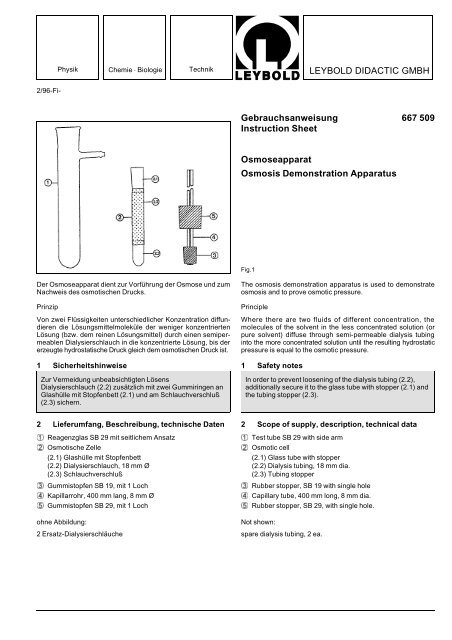

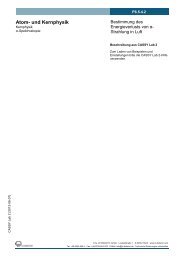
![[667 359] Labor-Refraktometer - LD DIDACTIC](https://img.yumpu.com/24788329/1/184x260/667-359-labor-refraktometer-ld-didactic.jpg?quality=85)
